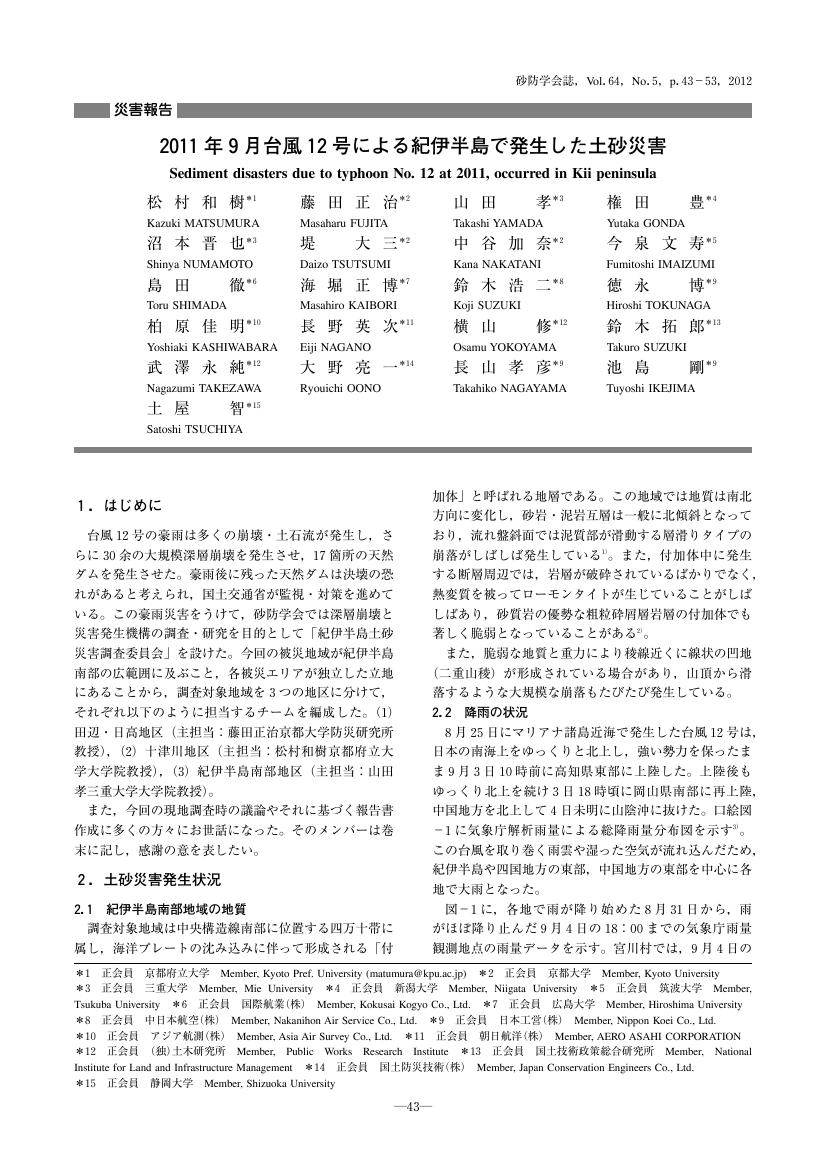2 0 0 0 OA スギ・ヒノキ林における水平根が発揮する抵抗力の検討
- 著者
- 木下 篤彦 坂井 佑介 大野 亮一 田畑 三郎 川島 正照 山崎 孝成
- 出版者
- 公益社団法人 砂防学会
- 雑誌
- 砂防学会誌 (ISSN:02868385)
- 巻号頁・発行日
- vol.65, no.5, pp.11-20, 2013-01-15 (Released:2015-08-03)
- 参考文献数
- 11
- 被引用文献数
- 8
Tree roots with an underground lateral network play a very important role in slope stability. In studies such as those by Tsukamoto(1987)and Abe(1997), the authors focused on roots that have a vertical connection between the surface soil layer and below, but they did not place much emphasis on the lateral spread of roots. Because slope failures occur in three dimensions, horizontal roots fully demonstrate their resistance against the failure. This paper aims to describe the resistance force Δ C that lateral roots provide. Two types of field investigations were made. One was the root pulling test to monitor the strength of a root pulled by a clamp. The other surveyed the lateral root distribution exposed in vertical sections excavated in the plots of Japanese cypress and cedar forests. The observed root distribution was used to calculate the resistance force Δ C. The field data show that as the distance between two trees increases, the Δ C value gets smaller. Their relationship can be described by a negative power function. It has also been proven that as the age of a tree increases so does the Δ C, but its increment gets smaller in the later stages of the tree's lifecycle. Intensive work with the field data has shown that forest thinning operations might decrease the root volume after felling and bring about an increase of Δ C that lasts for several decades. Moreover, thinning operations produce good results in slope stability when lateral roots are effectively increased. However, if the increase is insufficient, it might not contribute to slope stability.
1 0 0 0 OA 最近の動向をふまえた飽和不飽和浸透数値計算法の検討
- 著者
- 大野 亮一 鈴木 雅一 太田 猛彦
- 出版者
- 公益社団法人 砂防学会
- 雑誌
- 砂防学会誌 (ISSN:02868385)
- 巻号頁・発行日
- vol.51, no.4, pp.3-10, 1998-11-15 (Released:2010-04-30)
- 参考文献数
- 18
- 被引用文献数
- 3
Prediction of ground water movement is very important and critical to forecasting slope failure because many slope failures are triggered by the surcharge of water weight and drop of suction when precipitation infiltrates into soils. It is necessary to consider both saturated and unsaturated flow phases, particularly for sequentially estimating ground water flow to specify the time and location of the failure.Richards' equation has strong nonlinearity of coefficients. As a result, its numerical analysis tends to be much more difficult than that under moderate conditions, especially with very dry soils or a perched water table. Recently, new methods to solve Richards' equation that focused on diminishing water balance errors and less limitation of time step size were presented (Celia 1990, Pan 1995). In this paper, those new methods are first introduced with explanation of their algorithms specified for balance errors or time step size. Second, based on the fact that both steady and unsteady phases are combined in Richards' equation, the consequent oscillation problem is demonstrated and examined. The algorithm of the oscillation is explained with the analytic method presented in this paper.
